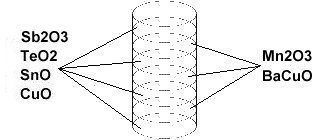



While the scientific community continues to pretend that room-temperature superconductivity has not yet been achieved, Superconductors.ORG herein reports the discovery of room temperature superconductors number 25 and 26 - further advancing the world record for high Tc.
Sn9SbTe4Ba2MnCu15O30+ displays a critical transition temperature (Tc) near 136C (276F) and Sn10SbTe4Ba2MnCu16O32+ transitions near 141C (285F). Superconductivity at these temperatures was confirmed by averaging numerous resistance and magnetization tests.1

|
Examples of both cooling and heating resistance tests are shown at page top. Despite a low volume fraction of the desired phase, sharp resistive transitions can easily be seen above the background noise. The straight lines drawn through the noise represent the average of the data points. Below is a magnetization plot of Sn10SbTe4Ba2MnCu16O32+, showing a Meissner transition of about 25 milli-Gauss near 140C. (Down is more diamagnetic and up is more magnetic.) 
To grasp how exceptionally high these temperatures are, consider that 141 Celsius is warmer than the melting points of more than 45 different solder alloys. Resistance and magnetization plots for the progenitor compound Sn9SbTe4Ba2MnCu15O30+ are shown below. |


These two new formulations resulted from expanding the unit cell of the 129C superconductor announced in March 2015. One extra Sn-Cu-O2 layer was added to reach 136C and two extra Sn-Cu-O2 layers were added to reach 141C. The target structure thus expands from P212 to R212 and T212 respectively (T212 is shown above left2). Since the 129C formulation was over-doped with electrons in the insulating layers, adding more Sn-Cu-O2 better optimizes the net charge while increasing the planar weight ratio along the C axis.
The dots within the below grid show how Tc has advanced in the copper-oxides through correspondingly higher planar weight ratios. Those compounds in the yellow box not only have the highest planar weight ratios, they feature a high dielectric constant (K) as well. At the same PWR, the high Kappa compounds have significantly higher transition temperatures.

In order to maximize formation of the T212 structure, Sn10SbTe4Ba2MnCu16O32 was synthesized using the layer cake method, as shown below. The pellet had approximately 100 interference layers. And, even using this layering technique, the volume fraction is low, requiring very sensitive test equipment.

Stoichiometric ratios of the below chemicals were used for the ODD layers:
SnO 99.9% (Alfa Aesar) 7.20 grains...and the below ratios for the EVEN layers.
BaCuO 99.9% (Alfa Aesar) 2.32 grainsThe chemical precursors were pelletized at 60,000 PSI and pre-sintered for 24 hours at 715C. The pellet was then sintered for 10 hours at 880C and annealed for 10+ hours at 500C in flowing O2. Temperature was determined using an Omega type "T" thermocouple and precision OP77 DC amplifier. The magnetometer employed twin Honeywell SS94A1F Hall-effect sensors with a tandem sensitivity of 50 mv/Gauss.
RESEARCH NOTE: The copper-oxides are strongly hygroscopic. All tests should be performed immediately after annealing.
RE-PUBLICATION NOTICE: Elsevier Publishing, dba Elsevier Science, as well as Morris Communications, both print and broadcast divisions, are specifically prohibited from re-publishing any part of this news story.
E. Joe Eck
© 2015 Superconductors.ORG
All rights reserved.
1. Testing temperatures are believed accurate within ± 0.5 degrees C.
2. Dielectric constants were obtained from H. P. R. Frederikse, CRC Handbook of Chemistry and Physics.
 BACK to "News" page at Superconductors.ORG
BACK to "News" page at Superconductors.ORG